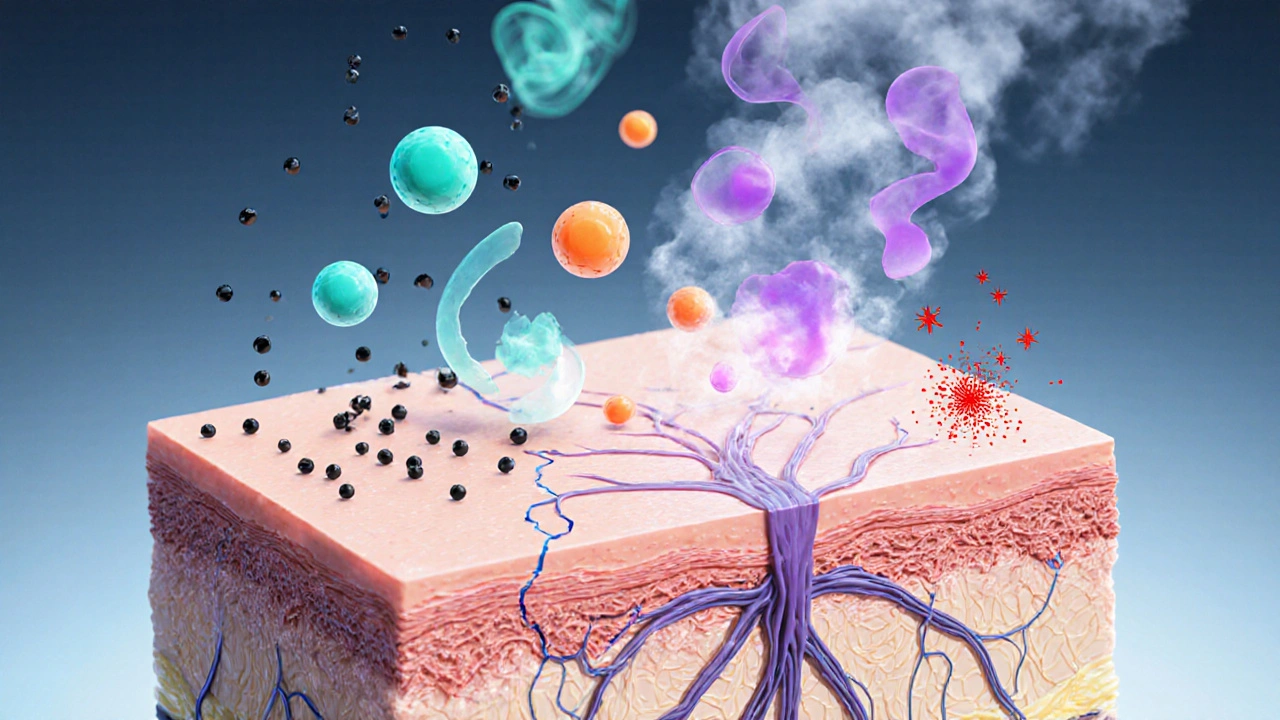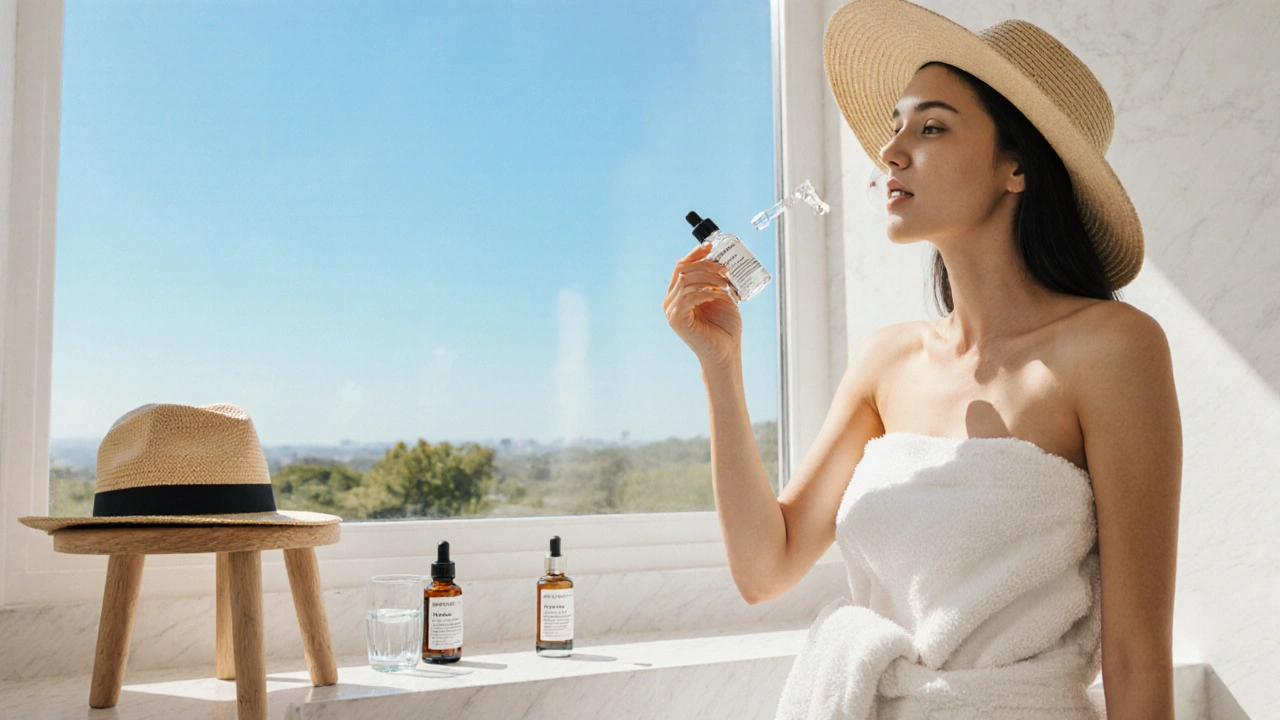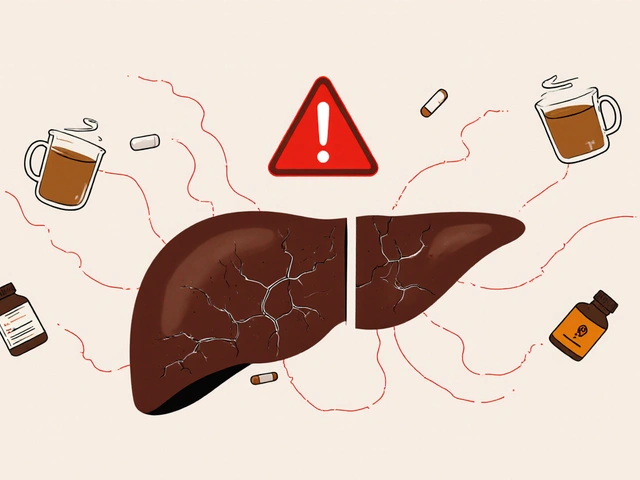
Air Pollution & Skin Health Quiz
Question 1: Which pollutant is primarily responsible for oxidative stress in the skin?
Question 2: What skin issue is caused by ozone stripping lipids from the skin barrier?
Question 3: Which ingredient is best for repairing the skin barrier against pollutants?
When you step out on a smoggy morning, the first thing you notice might be a burning throat or a cough, but many people overlook what’s happening to their skin. That invisible haze can spark itching, redness, and even chronic dermatitis. Understanding air pollution skin irritation helps you protect your body’s largest organ before the damage becomes permanent.
What is air pollution?
Air pollution is a mixture of harmful substances-gases, particles, and biological materials-mixed into the atmosphere. Common culprits include particulate matter (PM2.5 and PM10), ozone (O₃), nitrogen dioxide (NO₂), sulfur dioxide (SO₂), and volatile organic compounds (VOCs). Sources range from vehicle exhaust and industrial emissions to wildfires and household heating.
How skin irritation is defined
Skin irritation refers to any inflammatory response of the epidermis and dermis that manifests as redness, itching, swelling, or rash. Dermatologists categorize it as acute (short‑term) or chronic (long‑term) based on duration and severity. While allergies and irritants like soaps can cause similar symptoms, air pollutants act in distinct ways that we’ll explore below.
The main pollutants that hit your skin
The skin is constantly exposed to the outdoors, making it a frontline target for airborne toxins. Below is a quick rundown of the top offenders.
- Particulate Matter (PM2.5) consists of tiny particles smaller than 2.5 micrometers. They can lodge deep in pores, generating free radicals that damage collagen.
- Ozone (O₃) is a reactive gas formed when sunlight mixes nitrogen oxides and VOCs. It strips lipids from the skin barrier, leading to dryness.
- Nitrogen Dioxide (NO₂) originates from diesel engines and power plants. It provokes inflammation by activating inflammatory pathways like NF‑κB.
- Sulfur Dioxide (SO₂) mainly comes from coal combustion. It can convert to sulfates that irritate the skin’s surface pH.

How pollutants provoke skin problems
Three biological mechanisms explain the link between polluted air and irritated skin:
- Oxidative stress: Reactive particles generate free radicals that overwhelm the skin’s antioxidant defenses, breaking down elastin and collagen.
- Barrier disruption: Gases like ozone dissolve the lipid matrix that keeps moisture in, leaving the skin flaky and more permeable to allergens.
- Inflammatory signaling: Certain chemicals bind to receptors on keratinocytes, triggering cytokine release (IL‑1, IL‑6, TNF‑α) that results in redness and itching.
Studies from the European Academy of Dermatology in 2023 showed a 21% increase in eczema flare‑ups among residents of cities with average PM2.5 levels above 35µg/m³.
Real‑world examples
Consider two scenarios:
- Urban commuter: A 30‑year‑old living in downtown Auckland walks to work daily during a seasonal haze. After a month, they notice persistent facial redness that fades only after staying indoors.
- Mountain‑town resident: A 45‑year‑old in a low‑pollution area experiences occasional skin dryness but recovers quickly with standard moisturizers.
The contrast illustrates how chronic exposure amplifies skin vulnerability.
Protecting your skin: Practical steps
Below is a checklist you can start using today.
- Cleanse wisely: Use a gentle, sulfate‑free cleanser in the morning to remove surface pollutants without stripping natural oils.
- Apply barrier‑repair moisturizers: Look for ceramides, niacinamide, and hyaluronic acid to replenish the lipid matrix.
- Use antioxidant‑rich serums: Antioxidant creams containing vitamin C, vitamin E, or ferulic acid neutralize free radicals.
- Wear physical protection: Wide‑brimmed hats and UPF‑rated clothing reduce direct contact with ozone and UV radiation, which can act synergistically with pollutants.
- Check air quality indexes (AQI): On high‑pollution days, limit outdoor time or wear a breathable, filtered mask.
- Stay hydrated: Adequate water intake helps maintain skin elasticity and supports detox pathways.
Comparison of major pollutants and skin effects
| Pollutant | Primary Skin Issue | Mechanism |
|---|---|---|
| PM2.5 | Redness, premature aging | Oxidative stress, deep pore penetration |
| Ozone (O₃) | Dryness, barrier breakdown | Lipid oxidation, barrier disruption |
| NO₂ | Inflammation, eczema flare‑ups | Cytokine activation (NF‑κB) |
| SO₂ | Acidic irritation, pH imbalance | Conversion to sulfates, surface acidity |

When to see a dermatologist
If you notice any of the following, schedule an appointment with a skin specialist:
- Persistent redness lasting more than two weeks despite home care.
- Blistering, crusting, or oozing lesions.
- Severe itching that disrupts sleep.
- Signs of infection, such as pus or spreading warmth.
Dermatologists can perform patch testing, prescribe topical steroids, or suggest systemic treatments based on the severity.
Future outlook: Cleaner air, healthier skin
Policy changes matter. The New Zealand government’s 2024 Clean Air Act aims to cut PM2.5 emissions by 30% by 2030, which could translate into measurable reductions in dermatological complaints. On an individual level, the rise of smart air‑purifiers and wearable AQI monitors empowers people to act before a flare‑up occurs.
Key takeaways
- Air pollutants, especially PM2.5, ozone, and nitrogen dioxide, directly irritate the skin through oxidative stress, barrier damage, and inflammation.
- Protective routines-gentle cleansing, antioxidant serums, barrier‑supporting moisturizers, and AQI‑aware exposure-significantly lower risk.
- Persistent or severe symptoms warrant professional medical evaluation.
Frequently Asked Questions
Can indoor air quality affect my skin?
Yes. Indoor sources like cooking fumes, tobacco smoke, and off‑gassing from furniture release PM2.5 and VOCs that can trigger similar skin reactions as outdoor pollution. Using HEPA filters and ventilating rooms helps keep indoor skin irritation at bay.
Do sunscreen products protect against air pollution?
Broad‑spectrum sunscreens defend against UV radiation, which can amplify pollutant‑induced damage. Some modern formulas also include antioxidants that neutralize free radicals from pollutants, offering a dual shield.
Is there a specific diet that helps skin resist pollution?
Foods rich in omega‑3 fatty acids (salmon, flaxseed), vitamin C (citrus, berries), and polyphenols (green tea, dark chocolate) boost systemic antioxidants, which in turn support skin resilience against oxidative stress from pollutants.
How often should I replace my facial cleanser if I live in a polluted city?
A gentle cleanser used twice daily can be kept for up to three months, but if you notice residue buildup or increased irritation, switch to a fresh bottle earlier. The active ingredients can degrade when exposed to air pollutants themselves.
Do masks help protect my skin as well as my lungs?
A well‑fitted N95 or surgical mask filters out most PM2.5 particles, reducing the amount that lands on facial skin. However, masks can trap heat and humidity, so choose breathable fabrics and change them regularly to avoid mask‑related acne.




4 Comments
Wow, the way airborne nasties can mess with our skin is absolutely mind‑blowing!!! 🌬️✨ From tiny PM2.5 specks sneaking into pores to ozone violently stripping away lipids, the damage cascade is like a fireworks show gone wrong!!! First, those particles generate a storm of free radicals that assault collagen, then the barrier gets hacked open, leaving moisture fleeing like a scared rabbit!!! The inflammation that follows turns your cheek into a reddened billboard advertising stress!!! And guess what, this isn’t just a one‑time drama; chronic exposure turns your skin into an over‑reactive battlefield!!! Imagine walking through smog and feeling that tight, itchy sensation that just won’t quit!!! It’s basically your skin crying out for help!!! The good news? You can arm yourself with antioxidant serums, ceramide‑rich moisturizers, and sensible habits like checking the AQI before you step out!!! A gentle, sulfate‑free cleanser sweeps away the pollutants without stripping the love‑rich oils!!! Barrier‑repair creams loaded with niacinamide act like a shield, locking in hydration and fending off irritants!!! And don’t forget the power of a good hat and UPF clothing – they’re like sunscreen for the whole body!!! Staying hydrated internally supports that radiant glow, too!!! In short, knowledge + a solid routine = a happy, resilient complexion!!! Let’s keep those pores clean and our spirits high!!! 🌟💪
I totally feel you on the irritation struggle 😊💖 It's so easy to forget our skin needs love when the air is heavy. Remember to be gentle with yourself and let your routine be a soothing ritual. 🌿✨
Its realy intresting how we breathe in bad air.
The article correctly notes that ozone oxidizes skin lipids; however, the phrase "strips lipids from the skin barrier" could be clarified-ozone induces lipid peroxidation rather than literal stripping.